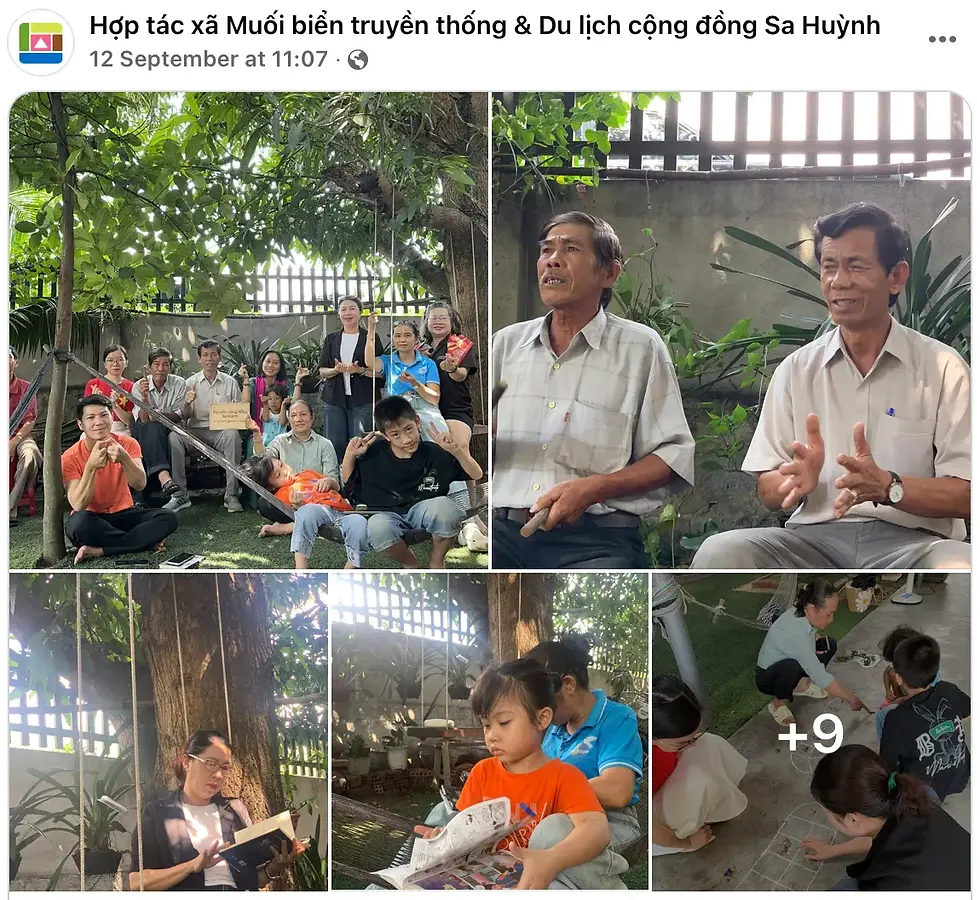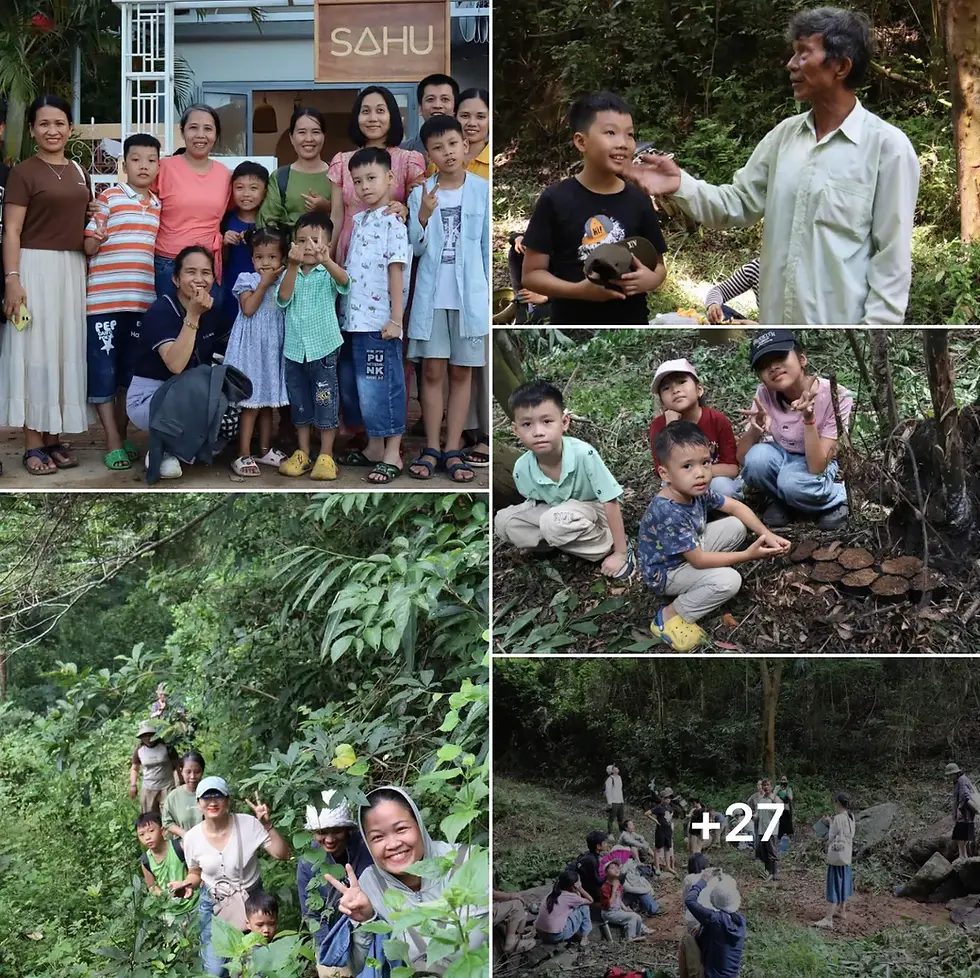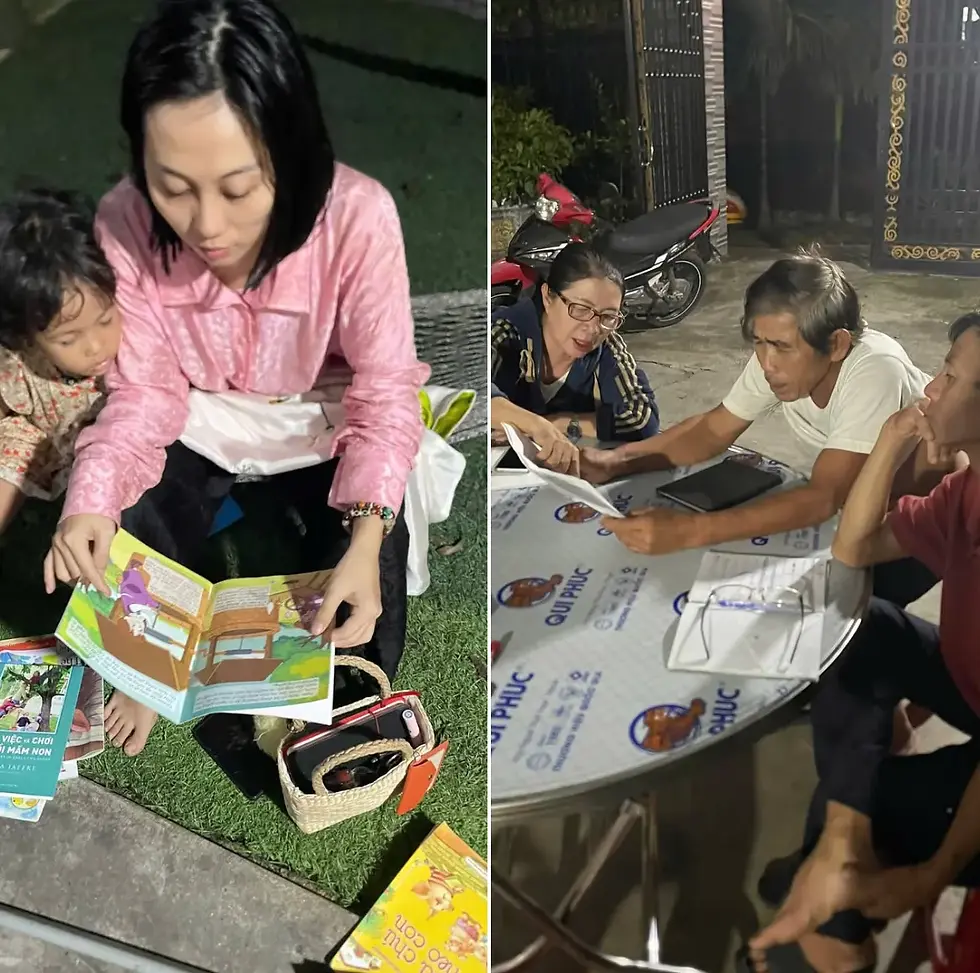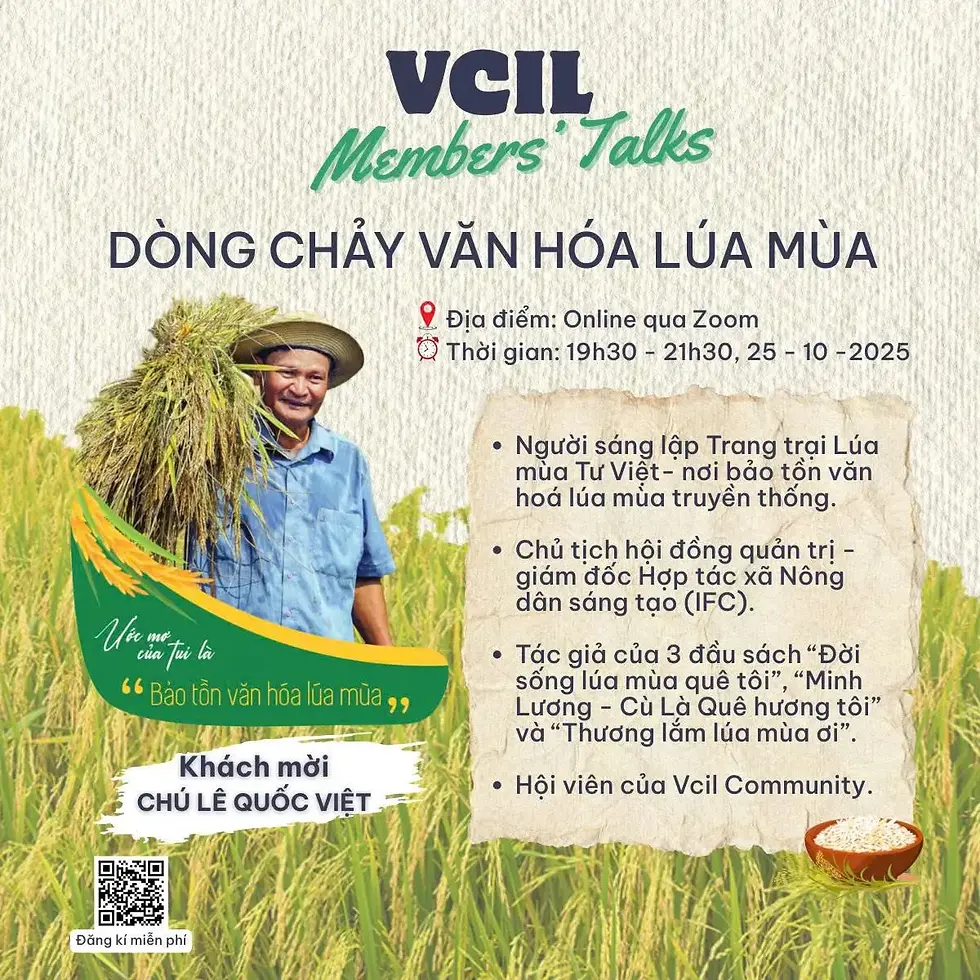From Preserving Sa Huỳnh's Traditional Salt-Making Craft to Community Regeneration
- VCIL Community
- Oct 1
- 14 min read
ABOUT VCIL MEMBER’S TALKS
Vcil Members’ Talks is a platform where the community can share stories, initiatives, and models currently being put into practice with a wider audience. It is also a valuable opportunity for people to connect with one another, especially those on a journey to find a meaningful career or to develop regenerative economic models.

The very first Vcil Member's Talks #1, held on September 10th, was organized around a topic of great community interest: "From Preserving Sa Huỳnh's Traditional Sea Salt to Community Regeneration." The special guest for the event was Ms. Phạm Hồng Thắm, widely known as the founder of the salt brand Sahu.vn. She is also the person who is currently accompanying the local people to build a community-based learning tourism model. This model aims to preserve the traditional salt fields while simultaneously regenerating and strengthening relationships and cohesion among community members.

MS. THẮM'S ENTREPRENEURIAL JOURNEY: FROM LAW SCHOOL TO ELEVATING THE VALUE OF TRADITIONAL SALT
Ms. Phạm Hồng Thắm's entrepreneurial journey began unexpectedly and completely outside her initial plans. After graduating with a Law degree from Vietnam National University, Ho Chi Minh City, she had a clear path to becoming a lawyer. However, in 2015, an article about the devastating drop in the price of Sa Huỳnh salt—where one tạ (100kg) of salt couldn't even buy a bowl of phở—deeply affected her. Her decision to return to her hometown of Sa Huỳnh at that time was merely an experiment, done during the downtime while waiting for a job application, with no intention of abandoning her law major. She considers herself a very ordinary person, and this startup process was simply a natural personal development.

Observing the market, she noticed the nascent trend of consuming clean food (around 2015-2016). She believed that Sa Huỳnh salt, made on natural clay/soil beds and of good quality, fully met the 'clean' criteria of this market. Her initial goal was simply to find a way to sell the salt at a higher price to improve the livelihoods of the salt farmers and prevent them from being squeezed by traders. The Sahu brand was born within just one month. Initially, she had no experience in production or knowledge of legal paperwork. However, thanks to the accommodating nature of the 'clean' market at the time, she was able to make sales and became a pioneer in the niche of clean salt.
As orders increased (from 1-2 bags to 100-200 bags), she realized that sales needed to be organized to ensure consistent quality. This forced her to quickly learn, set up a workshop, and register the business. Although she still tried to find an office job, her dedication to producing a quality product, keeping promises, and fulfilling the manufacturer's responsibility to customers gradually led her to commit fully to salt. She even worked at a food company for two months to learn about the supply chain and QA/QC (Quality Assurance/Quality Control) before fully focusing on Sahu.
After nearly 10 years of persistence, from those fledgling steps, she realized, "the salt profession chose me." Although she initially faced many difficulties, experiments, and even confusion, she always adhered to the principle of "don't lose the core value"—which was to resolutely choose the clay-bed salt (even though it's harder to make and cheaper) for the sake of sustainability. With a resourceful spirit and by avoiding large debts, she gradually developed the brand, proved the value of traditional salt, and finally decided to return to her hometown to establish a long-term career, viewing it as a natural and fortunate process of personal growth.
The Core Difference: Industrial Salt vs. Sa Huỳnh Sea Salt
Ms. Thắm clarified the fundamental differences between the two main types of salt on the market. Industrial salt (or refined salt) is a product that has undergone a chemical refining process, the purpose of which is to remove impurities and is usually supplemented with Iodine. This process removes almost all the valuable trace minerals from the seawater, leaving it as nearly just Sodium Chloride (NaCl) and Iodine. In contrast, Sa Huỳnh sea salt is made using the traditional solar salt method. This salt does not undergo chemical refining, thereby retaining the full richness of natural minerals from the seawater. This is why traditional sea salt is particularly favored by modern consumers who want to avoid chemicals and do not require excess Iodine supplementation.
Difference in Cultivation: Clay-Bed Salt vs. Tarp-Bed Salt

Right at the Sa Huỳnh salt field, two different cultivation methods exist, determining the quality and sustainable value of the salt grain. Tarp-Bed Salt is created when salt farmers lay plastic sheets on the field to allow seawater to condense and crystallize. This method yields cleaner, whiter salt grains and is purchased by traders at a higher price. However, Ms. Thắm resolutely rejects this type of salt due to concerns about health and the environment: the crystallization process at high temperatures could cause exposure to microplastics, and the thick tarps, once damaged, become a major source of plastic waste.
In contrast, Clay-Bed Salt is the traditional method, where salt crystallizes directly on the natural clay layer of the salt field. Ms. Thắm believes this is the most sustainable cultivation method. The clay bed not only creates salt grains with a delicious, soulful flavor but is also an essential part of a vital ecosystem. Although clay-bed salt is easily mixed with impurities and has a lower traditional market value, Sahu remains committed to this choice, as it represents the brand's core values and responsibility to the environment and consumer health.
Challenges and Solutions When Pursuing Clay-Bed Salt
The persistence with clay-bed salt comes with significant challenges. Clay-bed salt is easily dirtied and mixed with sediment if farmers are not meticulous or if the weather is poor, leading to customer complaints. To overcome this obstacle, Sahu has implemented two strategic solutions.
First, Sahu offers a purchasing policy to buy clay-bed salt at the highest price in the field (even higher than tarp-bed salt) to encourage and motivate farmers to work more carefully and cleanly.
Second, Sahu invests in a strict and manual preliminary processing after purchase, including picking out individual grains of sand from the salt. The combination of resolutely maintaining the traditional method (clay bed) and applying modern techniques (pre-processing) is essential to ensure the natural product still achieves high quality and customer satisfaction.
The Value of the Salt Field Ecosystem

During her business and salt-purchasing process, Ms. Phạm Hồng Thắm gradually realized that the traditional salt field is not merely a production site but an incredibly valuable ecosystem, extending far beyond the economic value of the salt grain.
Unlike industrial salt fields, the Sa Huỳnh salt field is built on an impermeable clay layer, allowing seawater to condense naturally through a complex system of canals and evaporation ponds. This ecosystem provides numerous major environmental benefits.
Specifically, the salinity gradient across the ponds creates an ideal habitat for shrimp, fish, crabs, seaweed, moss, and algae, acting as a natural nursery that provides seafood resources for local fishermen. Furthermore, the clay layer in the salt field has been recognized for its effective carbon storage capabilities, and the salt field also contributes to local flood control. She emphasizes that the salt grain created on this traditional salt field carries a sustainable, completely free energy source (seawater, wind, sun, soil, tides).
Despite having improved the livelihood problem for salt farmers through the high-price purchasing policy, Ms. Thắm still faces two major issues that a sole business cannot solve. The reasons that prompted her to shift towards community activity are environmental pollution and the risk of land loss. The salt field is seriously threatened by domestic waste dumped into the saltwater lagoon, constantly polluting the seawater—the fundamental component for creating clean salt. Moreover, the salt field faces the risk of being zoned for development projects (recently, 10 hectares of the salt field were filled in) to create urban areas or industrial zones, as the salt field is less economically efficient than other economic projects from a financial perspective.
Ms. Thắm felt powerless, realizing she "cannot go and clean up all the trash" or influence policy as just a business.
Why Not Choose to Buy the Land for Preservation?
A question was raised about why Ms. Thắm didn't purchase the entire salt field for preservation. She stated that if Sahu (or she personally) owned the salt field, it would create major problems, particularly a rift in the community and a lack of sustainability in long-term preservation efforts.
First, privatization would erode the cultural and historical value of the Sa Huỳnh salt-making craft. The salt-making here is a hereditary profession, tied to community culture and the connection between salt farmers across generations. If Ms. Thắm bought the land, the salt farmers would lose their traditional role as owners and become laborers or employees for the business. This would strip the meaning from the tradition of passing the craft down, eroding the inherent historical and community cultural values of the salt-making profession.
Second, individual ownership does not provide genuine conservation power. Ms. Thắm posed the question: "Can Thắm control people from throwing trash into the saltwater lagoon or the sea, or control the government's development zoning?" No matter how large a business is, it's just one entity. If the salt field becomes private property, the community will no longer have a reason to care or unanimously protect the environment and ecosystem. In that case, if there's a risk of pollution or development, she would have to bear it alone, and she believes this independent ownership "would be meaningless in the work of conservation."
Ms. Thắm affirms that the salt field is a complex ecosystem that cannot be managed independently like a vegetable garden. Therefore, the most sustainable and effective solution is for the community to own it (under a community mechanism) and raise their awareness. Only the strength of the community is large enough to create solidarity, have a voice for sustainable development, and self-protect its living environment. She accepts the path of community education, even though it is difficult and slow, because she believes it is the only way toward long-term sustainable development.
COMMUNITY LEARNING TOURISM INITIATIVE - A TOOL FOR CONSERVATION AND COMMUNITY DEVELOPMENT
After recognizing the difficulties and dead ends, Ms. Thắm found the key in the Community Learning Tourism (CLT / Community-engaged Learning Tourism) model. This initiative was developed with Mr. Chu Mạnh Trinh (a conservation expert at Cù Lao Chàm and the initiator of this model) and supported by the UNDP project in 2023. Ms. Thắm asserts that this model's nature is conservation, using tourism as a tool. The goal is not to make money, but to create shared value for the community.
This model was applied after she realized she could not completely solve the macro issues of environmental pollution and land development risks with individual or corporate power. This model marks the only path to creating sustainable change within the Sa Huỳnh community.
Operating Principles: Ownership and Sharing
The core difference of CLT lies in its operating principles and benefit-sharing, aimed at strengthening the ownership role of the local people:
First, the model operates with a non-profit objective. Ms. Thắm commits that all tour revenue collected will be entirely distributed to the community members directly involved in hosting guests (such as providing homestays, cooking, and guiding). The Cooperative (the legal entity operating the CLT model) retains only a very small portion to cover necessary operating costs. This ensures that the more people who benefit from this activity, the more people will collectively agree to protect the salt field, as they recognize that a clean environment is their source of economic benefit and livelihood.
Second, the local people are the owners of the services, not employees. In CLT, the cooks set their own menus and prices; the salt farmers proactively share their stories and salt-making techniques. This helps strengthen community culture and cohesion, maintaining values that would be lost if salt farmers were converted into laborers.
Core Activities of the Sa Huỳnh Community Learning Tourism Model
The Community Learning Tourism (CLT) model in Sa Huỳnh is an initiative that is not merely a tourist experience but a continuous process of education and community development, designed to serve a dual goal: creating sustainable livelihoods and solving environmental and cultural problems from the root. The activities are divided into two main groups to ensure long-term participation and change in community awareness.

Experiential and Culture-Integrated Learning Activities
The tours within this model are designed to be deeply educational and experiential, distinguishing them from ordinary leisure tourism. Visitors directly participate in the traditional clay-bed salt-making process with the salt farmers, learning about the techniques, history, and culture of the craft. This helps salt farmers enhance their sense of ownership and the value of their profession. These activities also include cultural interaction experiences such as staying at a homestay and enjoying local cuisine (with menus created and served by the locals). Specifically, visitors participate in ecosystem experience activities to learn about the salt field's value as a natural nursery and its role in combating climate change. Finally, guests are invited to take part in practical conservation activities such as planting đưng trees (a species that helps filter heavy metals in the saltwater lagoon) alongside the community or cleaning up trash.

Education and Community Awareness-Raising Activities
This is a decisive series of activities aimed at creating sustainable and long-term mindset change. The Cooperative continuously organizes training sessions and workshops to raise public awareness about urgent issues such as environmental consciousness, waste management methods (waste sorting), and the importance of protecting the seawater source. The goal is for the community to understand why they must protect the environment, not just because of the law, but because of their direct benefits and economic livelihoods.
More importantly, Ms. Thắm places special emphasis on investing in children's education by establishing a community library and organizing activities to create a deep connection with nature. She believes that nurturing love and respect for the environment from a young age will create a next generation with a conservation mindset, thereby ensuring sustainability for the next 10–20 years.

Model's Objectives: Sustainable Conservation and Community Empowerment
The goals of Community Learning Tourism (CLT) revolve around two main pillars, both linked to empowering and promoting collective strength.
The primary conservation objective is to solve the problem of garbage pollution and threats from development zoning, by restoring the quality of the seawater source and preserving the craft village culture (maintaining the salt farmers' ownership role).
Regarding the community development objective, the model helps create equitable livelihoods as economic benefits are shared fairly (all tour revenue is distributed) among many people. Most importantly, the goal is to create collective strength and a common voice that is large enough. Ms. Thắm believes that the power of the community is the only tool that can drive sustainable development, something an individual business cannot achieve.
The model's results are measured by conservation outcomes and the change in local people's awareness, focusing on long-term development rather than short-term profits.
It can be said that Community Learning Tourism is both a green economy model and a social education method. It harmonizes the benefits of all three parties: the community develops, the environment is conserved, and visitors gain knowledge and profound experiences.
Q&A SESSION WITH MS. THẮM
The Q&A session delved into the practical issues Ms. Thắm faces, clarifying Sahu's business philosophy and path to sustainable development.
Q: You purchase salt at a price higher than normal traders, but customers are also very sensitive to market prices. Does the price difference create any difficulty for selling the salt?
Ms. Thắm explained that the retail price is generally kept fixed for 1–2 years, because salt is a slow-consumption item and she factored in projected cost increases from the start. The purchasing policy is to coordinate purchases based on quality and market, always buying at a higher price than traders and paying the highest price for quality salt to encourage farmers.
She accepts compensating for losses during poor harvest years with accumulated profits from good years, because she believes that maintaining the livelihood of the salt farmers is a responsibility. Regarding quality, although a natural product cannot be 100% uniform, Sahu is committed to maintaining a mandatory standard by applying modern pre-processing techniques to remove impurities, ensuring the salt delivered to customers is always clean and of a high standard.
Q: How did you persuade the local people to accompany you?
Ms. Thắm shared that persuading local people to join the Community Learning Tourism model was an extremely difficult and slow process, far from smooth. Initially, the locals, especially the elderly, found it very hard to change their mindset because they were only focused on immediate economics and profit, lacking a conservation or environmental mindset. She admitted that she could not use a "preaching" attitude but had to use trust and benefit. She adopted a gradual approach, first gathering people with the same wavelength and passion for their hometown, even if the number was very small (initially just a few salt farmers).
The main strategy is through the benefit-sharing mechanism of the CLT model: She commits to distributing all tour revenue to the community members directly involved. This helps people see the direct economic benefit of protecting a clean environment, because a beautiful environment attracts tourists. Simultaneously, she continuously organizes training and education to raise awareness, helping them understand why they must protect the environment, turning participation from an obligation into a voluntary action and self-ownership of their work. Ms. Thắm also had to learn to let go of the ambition of having everyone participate, focusing instead on those who were willing, thereby creating small success stories to gradually spread the message.
Q: What advice do you have for young people who also want to do community work like you? First, determine that this is a difficult and long-term path. Ms. Thắm advises people to learn to be patient and not be affected by disappointment when expectations are not met. They need to accept that big change won't happen immediately.
Second, they need to balance a warm heart (noble goals, core values) with a cool head (market, financial calculation). Even when doing community work, you must ensure the model is viable and must not lose your core values.
Third, focus on educating the future generation. Ms. Thắm commented that investing in children (like building libraries or nature aesthetics activities) is the most effective and highly sustainable strategy, as it creates a root-level change in mindset for the next 10–20 years, ensuring current efforts are not wasted.
Finally, she emphasized remembering that starting a business is simply doing something better than others are doing,and protecting the environment is the responsibility of an ordinary citizen, it doesn't need to be something huge or overwhelming.
Q: Is there a difference between Community Tourism and Community Learning Tourism?
CLT is not a typical tourism model but a tool for conservation and sustainable development. Its goal is not to grow revenue or customer numbers like commercial Community Tourism models. Instead, CLT aims for growth in awareness, community capacity, and ecosystem quality (such as the number of đưng trees planted or the level of waste reduction). Essentially, if Community Tourism is a tourism business product, CLT is a means of education and regenerative practice. This is evident in the fact that CLT's results are measured by conservation outcomes, not profit.
The clearest difference lies in the operating method and benefit-sharing. In CLT, the Cooperative commits to distributing all tour revenue to the community members directly involved in hosting guests (cooking, homestays). The biggest benefit created is the common value (cleaner environment, protected salt field) that the entire community enjoys, even those not involved in hosting guests.
Furthermore, CLT helps local people maintain their traditional role as owners, deciding on services and sharing their culture themselves. This is completely different from regular Community Tourism models, where profits often concentrate in a small group or organizing company, and locals tend to become employees. This empowerment of ownership is the key factor in strengthening community culture and cohesion—factors that cannot be bought with money. Ultimately, with CLT, the local community must be the beneficiary of this tourism activity. The local community must become more confident in their own abilities, and grow to love their land, culture, and history more. Therefore, they will strive to protect their homeland.
CONNECTION INFORMATION AND NEXT ACTIVITIES
Vcil Community will continue to organize monthly VCIL Member's Talks. Next month, the event will focus on the theme of rice season culture preservation, seasonal rice farming, native seed restoration, and the cultural story associated with nature-friendly agriculture in the Mekong Delta.
If interested, you can find more details here.

Ms. Thắm is one of the producers of the Vcil Consumer Club—a model that directly connects producers with consumers, aiming for a sustainable and equitable economy.
Vcil Community also plans to organize a Field Trip program next year for members to directly visit the clean production sites within the club, such as salt, rice, fish sauce, coffee, and more.
If interested in sustainable/regenerative production models, Vcil Community invites everyone to join as a member for the opportunity to connect with members who share the same values.
.png)
Comments